Pavia
Pavia (UK: /ˈpɑːviə/,[3] US: /pəˈviːə/,[4] Italian: [paˈviːa] (![]()
Pavia | |
|---|---|
| Città di Pavia | |
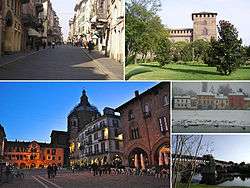 Top left: Corso Strada Nuova (Pavia New Avenue), main shopping area in Pavia, Top right: Veduta laterale sel Castello Visconteo (Pavia Visconti Castle), Bottom left: A view of the city's Cathedral from the Piazza della Vittoria (Vittoria Square), Bottom Upper right: Fiume Ticino, Bottom lower right: Ponte Coperto (Coperto Bridge) and Ticino River | |
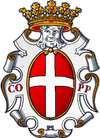 Coat of arms | |
.svg.png) Pavia within the Province of Pavia | |
Location of Pavia 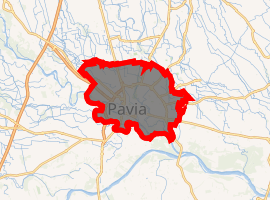
| |
 Pavia Location of Pavia in Lombardy 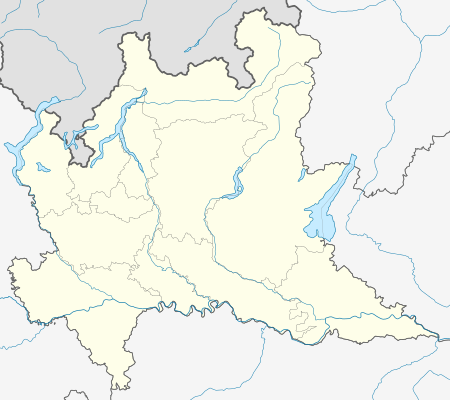 Pavia Pavia (Lombardy) | |
| Coordinates: 45°11′N 09°09′E | |
| Country | Italy |
| Region | Lombardy |
| Province | Pavia (PV) |
| Frazioni | Ca' della Terra, Cantone Tre Miglia, Cassinino, Cittadella, Fossarmato, Mirabello, Montebellino, Pantaleona, Prado, Scarpone, Villalunga |
| Government | |
| • Mayor | Fabrizio Fracassi (LN) |
| Area | |
| • Total | 62 km2 (24 sq mi) |
| Elevation | 77 m (253 ft) |
| Population (30 November 2016)[2] | |
| • Total | 73,086 |
| • Density | 1,200/km2 (3,100/sq mi) |
| Demonym(s) | Pavesi |
| Time zone | UTC+1 (CET) |
| • Summer (DST) | UTC+2 (CEST) |
| Postal code | 27100 |
| Dialing code | +39 0382 |
| ISTAT code | 018110 |
| Patron saint | Syrus of Pavia, Augustin |
Pavia is the capital of the fertile province of Pavia, which is known for a variety of agricultural products, including wine, rice, cereals, and dairy products. Although there are a number of industries located in the suburbs, these tend not to disturb the peaceful atmosphere of the town. It is home to the ancient University of Pavia (founded in 1361), which together with the IUSS (Institute for Advanced Studies of Pavia), Ghislieri College, Borromeo College, Nuovo College, Santa Caterina College, and the Istituto per il Diritto allo Studio (EDiSU), belongs to the Pavia Study System. Pavia is the episcopal seat of the Roman Catholic Bishop of Pavia. The city possesses many artistic and cultural treasures, including several important churches and museums, such as the well-known Certosa di Pavia.
The Central Hospital of Pavia is one of the most important hospitals in Italy.
History
Early history
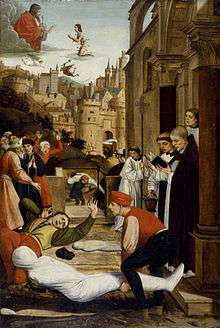
Dating back to pre-Roman times, the town of Pavia, then known as Ticinum, was a municipality and an important military site (a castrum) under the Roman Empire. It was said by Pliny the Elder to have been founded by the Laevi and Marici, two Ligurian tribes, while Ptolemy attributes it to the Insubres. The Roman city most likely began as a small military camp, built by the consul Publius Cornelius Scipio in 218 BC to guard a wooden bridge he had built over the river Ticinum, on his way to search for Hannibal, who was rumoured to have managed to lead an army over the Alps and into Italy. The forces of Rome and Carthage ran into each other soon thereafter, and the Romans suffered the first of many crushing defeats at the hands of Hannibal, with the consul himself almost losing his life. The bridge was destroyed, but the fortified camp, which at the time was the most forward Roman military outpost in the Po Valley, somehow survived the long Second Punic War, and gradually evolved into a garrison town.
Its importance grew with the extension of the Via Aemilia from Ariminum (Rimini) to the Po River (187 BC), which it crossed at Placentia (Piacenza) and there forked, one branch going to Mediolanum (Milan) and the other to Ticinum, and thence to Laumellum where it divided once more, one branch going to Vercellae - and thence to Eporedia and Augusta Praetoria - and the other to Valentia - and thence to Augusta Taurinorum (Turin).
It was at Pavia in 476 AD that the reign of Romulus Augustulus (r. 475-476), the last emperor of the Western Roman Empire ended and Roman rule ceased in Italy.[7] Romulus Augustulus, while considered the last emperor of the Western Roman Empire, was actually a usurper of the imperial throne; his father Flavius Orestes dethroned the previous emperor, Julius Nepos, and raised the young Romulus Augustulus to the imperial throne at Ravenna in 475.[8] Though being the emperor, Romulus Augustulus was simply the mouthpiece for his father Orestes, who was the person who actually exercised power and governed Italy during Romulus Augustulus's short reign.[9] Ten months after Romulus Augustulus's reign began, Orestes's soldiers under the command of one of his officers named Odoacer, rebelled and killed Orestes in the city of Pavia in 476.[10] The rioting that took place as part of Odoacer's uprising against Orestes sparked fires that burnt much of Pavia to the point that Odoacer, as the new king of Italy, had to suspend the taxes for the city for five years so that it could finance its recovery.[11] Without his father, Romulus Augustulus was powerless. Instead of killing Romulus Augustulus, Odoacer pensioned him off at 6,000 solidi a year before declaring the end of the Western Roman Empire and himself king of the new Kingdom of Italy.[12]
Odoacer's reign as king of Italy did not last long, because in 488 the Ostrogothic peoples led by their king Theoderic invaded Italy and waged war against Odoacer.[13] After fighting for 5 years, Theoderic defeated Odoacer and on March 15, 493, assassinated Odoacer at a banquet meant to negotiate a peace between the two rulers.[14] With the establishment of the Ostrogoth kingdom based in northern Italy, Theoderic began his vast program of public building. Pavia was among several cities that Theodoric chose to restore and expand.[15] He began the construction of the vast palace complex that would eventually become the residence of Lombard monarchs several decades later.[16] Theoderic also commissioned the building of the Roman-styled amphitheatre and bath complex in Pavia;[17] in the 7th century these would be among the few still functioning bath complexes in Europe outside of the Eastern Roman Empire.[18] Near the end of Theoderic's reign the Christian philosopher Boethius was imprisoned in one of Pavia's churches from 522 to 525 before his execution for treason.[19] It was during Boethius's captivity in Pavia that he wrote his seminal work the Consolation of Philosophy.[20]
Pavia played an important role in the war between the Eastern Roman Empire and the Ostrogoths that began in 535.[21] After the Eastern Roman general Belisarius's victory over the Ostrogothic leader Wittigis in 540 and the loss of most of the Ostrogoth lands in Italy, Pavia was among the last centres of Ostrogothic resistance that continued the war and opposed Eastern Roman rule.[22] After the capitulation of the Ostrogothic leadership in 540 more than a thousand men remained garrisoned in Pavia and Verona dedicated to opposing Eastern Roman rule.[23] The resilience of Ostrogoth strongholds like Pavia against invading forces allowed pockets of Ostrogothic rule to limp along until finally being defeated in 561.[24]
Pavia and the peninsula of Italy didn't remain long under the rule of the Eastern Roman Empire, for in 568, a new people invaded Italy. This new invading people in 568 were the Lombards (otherwise called the Longobards).[25] In their invasion of Italy in 568, the Lombards were led by their king Alboin (r. 560-572), who would become the first Lombard king of Italy.[26] Alboin captured much of northern Italy in 568 but his progress was halted in 569 by the fortified city of Pavia.[27] Paul the Deacon's History of the Lombards written more than a hundred years after the Siege of Ticinum provides one of the few records of this period: “The city of Ticinum (Pavia) at this time held out bravely, withstanding a siege more than three years, while the army of the Langobards remained close at hand on the western side. Meanwhile Alboin, after driving out the soldiers, took possession of everything as far as Tuscany except Rome and Ravenna and some other fortified places which were situated on the shore of the sea.”[28] The Siege of Ticinum finally ended with the Lombards capturing the city of Pavia in 572.[29] Pavia's strategic location and the Ostrogoth palaces located within it would make Pavia by the 620s the main capital of the Lombards’ Kingdom of Pavia[30] and the main residence for the Lombard rulers.[31]
Lombard capital
Under Lombard rule many monasteries, nunneries, and churches were built at Pavia by the devout Christian Lombard monarchs. Even though the first Lombard kings were Arian Christians, sources from the period such as Paul the Deacon have recorded that the Arian Lombards were very tolerant of their Catholic subjects’ faith and that up to the 690s Arian and Catholic cathedrals coexisted in Pavia.[32] Lombard kings, queens, and nobles would engage in building churches, monasteries, and nunneries as a method to demonstrate their piety and their wealth by extravagantly decorating these structures which in many cases would become the site of that person's tomb, as in the case of Grimoald (r. 662-671) who built San Ambrogio in Pavia and buried there after his death in 671.[33] Perctarit (r. 661-662, 672-688) and his son Cunicpert (r.679-700) built a nunnery and a church at Pavia during their reigns.[34] Lombard churches were sometimes named after those who commissioned their construction, such as San Maria Theodota in Pavia.[35] The monastery of San Michele alla Pusterla located at Pavia was the royal monastery of the Lombard kings.[36]
One of the most famous churches built by a Lombard king in Pavia is the church San Pietro in Ciel d'Oro. This famous church was commissioned by king Liutprand (r. 712-744)[37] and it would become the site of his tomb as well as two other famous Christian figures.[38] In building San Pietro in Ciel d'Oro the unit of measurement used by the builders was the length of Liutprand's royal foot.[39] The first important Christian figure interred at San Pietro in Ciel d'Oro was the previously mentioned philosopher Boethius, author of the Consolation of Philosophy, who is located in the cathedral's crypt.[40] The third and largest tomb of the three located in San Pietro in Ciel d'Oro contains the remains of St. Augustine of Hippo.[41] St. Augustine is the early 5th-century Christian writer from Roman North Africa whose works such as On Christian Doctrine revolutionized the way in which the Christian scripture is interpreted and understood.[42] On October 1, 1695, artisans working in San Pietro in Ciel d’Oro rediscovered St. Augustine's remains after lifting up some of the paving stones that compose the cathedral's floor.[43] Liutprand was a very devout Christian and like many of the Lombard kings was zealous about collecting relics of saints.[44] Liutprand paid a great deal to have the relics removed from Cagliari and brought to Pavia so that they would be out of the reach and safe from the Saracens on Sardinia where St. Augustine's remains had been resting.[45] Very little of Liutprand's original church of San Pietro in Ciel d'Oro consecrated by Pope Zacharias in 743 remains today.[46] Originally the roof of its apse was decorated with mosaics, making San Pietro in Ciel d'Oro the first instance of mosaics being used to decorate a Lombard church.[47] It is now a modern church with the only significant link to its antiquity being its round apse.[48] The Lombards built their churches in a very Romanesque style, with the best example of Lombard churches from the period of Lombardic rule being the Basilica of San Michele still intact at Pavia.[49]
As the kingdom's capital, Pavia in the late 7th century also became one of the central locations of the Lombards' efforts to mint their own coinage.[50] The bust of the Lombard king would have been etched on the coins as a symbolic gesture so that those who used the coins, mostly Lombard nobles, would understand that king had the ultimate power and control of wealth in the Kingdom of Pavia.[51]
The city of Pavia played a key role in the war between the Lombard Kingdom of Pavia and the Franks led by Charlemagne. In 773, Charlemagne king of the Franks declared war and invaded across the Alps into northern Italy defeating the Lombard army commanded by king Desiderius (r. 757-774).[52] Between the autumn of 773 and June of 774[53] Charlemagne laid siege to Pavia first and then Verona, capturing the seat of Lombard power and quickly crushing any resistance from the northern Lombard fortified cities.[54] Pavia had been the official capital of the Lombards since the 620s,[55] but it was also the place upon where the Lombard Kingdom in Italy ended. Upon entering Pavia in triumph, Charlemagne crowned himself king of the lands of the former Kingdom of Pavia.[56] The Lombard kingdom and its northern territories from then onwards were a sub-kingdom of the Frankish Empire, while the Lombard southern duchy of Benevento persisted for several centuries longer with relative independence and autonomy.[57]
Medieval history

In 924, the Hungarians, led by the deposed Lombard king, Berengar I, sacked and destroyed the city. Pavia remained the capital of the Italian Kingdom and the centre of royal coronations until the diminution of imperial authority there in the 12th century. In 1004, Holy Roman Emperor Henry II bloodily suppressed a revolt of the citizens of Pavia, who disputed his recent coronation as King of Italy.
In the 12th century, Pavia acquired the status of a self-governing commune. In the political division between Guelphs and Ghibellines that characterized the Italian Middle Ages, Pavia was traditionally Ghibelline, a position that was as much supported by the rivalry with Milan as it was a mark of the defiance of the Emperor that led the Lombard League against the emperor Frederick Barbarossa, who was attempting to reassert long-dormant Imperial influence over Italy. The city also had a reputation as a place to have a "good time," as witness the Archpoet's famous comments of 1163.[58]
In the following centuries Pavia was an important and active town. Under the Treaty of Pavia, Emperor Louis IV granted during his stay in Italy the Electorate of the Palatinate to his brother Duke Rudolph's descendants. Pavia held out against the domination of Milan, finally yielding to the Visconti family, rulers of that city in 1359; under the Visconti Pavia became an intellectual and artistic centre, being the seat from 1361 of the University of Pavia founded around the nucleus of the old school of law, which attracted students from many countries.
Early modern
The Battle of Pavia (1525) marked a watershed in the city's fortunes, since by that time, the former schism between the supporters of the Pope and those of the Holy Roman Emperor had shifted to one between a French party (allied with the Pope) and a party supporting the Emperor and King of Spain Charles V. Thus during the Valois-Habsburg Italian Wars, Pavia was naturally on the Imperial (and Spanish) side. The defeat and capture of king Francis I of France during the battle ushered in a period of Spanish occupation which lasted until 1713 at the conclusion of the War of the Spanish Succession. Pavia was then ruled by the Austrians until 1796, when it was occupied by the French army under Napoleon. During this Austrian period the University was greatly supported by Maria Theresa of Austria and oversaw a culturally rich period due to the presence of leading scientists and humanists like Ugo Foscolo, Alessandro Volta, Lazzaro Spallanzani, and Camillo Golgi among others.
In 1815, it again came under Austrian administration until the Second War of Italian Independence (1859) and the unification of Italy one year later.
Government
Main sights
Pavia's most famous landmark is the Certosa, or Carthusian monastery, founded in 1396 and located eight kilometres (5.0 miles) north of the city.
Among other notable structures are:
- Cathedral of Pavia (Duomo di Pavia): Construction of the cathedral began in 1488; however, only by 1898 were the façade and the dome completed according to the original design. The central dome has an octagonal plan, stands 97 m high, and weighs some 20,000 tons. This dome is the third for size in Italy, after St. Peter's Basilica and Santa Maria del Fiore in Florence. Next to the Duomo were the Civic Tower (existing at least from 1330 and enlarged in 1583 by Pellegrino Tibaldi): its fall on March 17, 1989, was the final motivating force that started the last decade's efforts to save the Leaning Tower of Pisa from a similar fate.
- San Michele Maggiore (St. Michael Major): This church is an outstanding example of Lombard-Romanesque church architecture in Lombardy. It is located on the site of a pre-existing Lombard church, which the lower part of the campanile belongs to. Destroyed in 1004, it was rebuilt from around the end of the 11th century (including crypt, transept and choir), and finished in 1155. It is characterized by an extensive use of sandstone and by a very long transept, provided with a façade and an apse of its own. In the church the Emperor Frederick Barbarossa was crowned in 1155.
- Basilica of San Pietro in Ciel d'Oro ("St. Peter in Golden Sky"): In this church, St Augustine, Boethius and the Lombard king Liutprand are said to be buried. Construction was begun in the 6th century. The current construction was built in 1132. It is similar to San Michele Maggiore, but different in the asymmetric façade with a single portal, the use of brickwork instead of sandstone, and, in the interior, the absence of matronei, galleries reserved for women and the shortest transept. The noteworthy arch housing the relics of St. Augustine was built in 1362 by artists from Campione, and is decorated by some 150 statues and reliefs. The church is mentioned by Dante Alighieri in the X canto of his Divine Comedy.
- San Francesco d'Assisi: This is a late Romanesque church (1238–98) with a restored Gothic façade, located on Corso Cairoli.
- San Teodoro: This church dating to 1117 and dedicated to Theodore of Pavia, a medieval bishop of the Diocese of Pavia, is the third. albeit smaller, Romanesque basilica in Pavia. Situated on the slopes leading down to the Ticino river, it served the fishermen. The apses and the three-level tiburium exemplify effective simplicity of Romanesque decoration. Inside are two outstanding bird's-eye-view frescoes of the city (1525) attributed to Bernardino Lanzani. The latter, the definitive release, was stripped off disclosing the unfinished first one. Both are impressively detailed and reveal how Pavia's urban layout has changed little in 500 years.
- Castello Visconteo: Built in 1360-1365 by Galeazzo II Visconti, this large castle served as a private residence rather than a stronghold. The poet Francesco Petrarca spent some time there, when Gian Galeazzo Visconti called him to take charge of the magnificent library which owned about a thousand books and manuscripts, subsequently lost. The Castle is now home to the City Museums (Musei Civici) and the park is a popular attraction for children. An unconfirmed legend wants the Castle to be connected by a secret tunnel to the Certosa.
- Santa Maria del Carmine: This church is a well-preserved example of Gothic brickwork architecture in northern Italy. Built on the Latin cross plan, it is the second largest Pavian church after the Duomo, with a perimeter of 80 x 40 meters comprising a nave and two aisles. The characteristic façade has a large rose window and seven cusps.
- Santa Maria di Canepanova: This renaissance octagonal church is attributed to Bramante.
- The medieval towers still shape the town skyline. The main clusters still rising are rallied in Piazza Leonardo da Vinci (three towers), Via Luigi Porta (two towers), and in Piazza of Collegio Borromeo. These towers are closed to the public.
Universities, colleges and other institutions
Pavia is a major Italian college town, with several institutes, universities and academies, including the ancient University of Pavia. Here is an incomplete list of the main institutions located in the city:
- The University of Pavia, one of the most ancient universities in Europe, was founded in 1361, although a school of rhetoric is documented in 825 making this center perhaps the oldest proto-university of Europe. The Centrale Building is a wide block made up of twelve courts of the 15th to 19th centuries. The sober façade shifts from baroque style to neoclassic. The Big Staircase, the Aula Foscolo, the Aula Volta, the Aula Scarpa and the Aula Magna are neoclassic too. The Cortile degli Spiriti Magni hosts the statues of some of the most important scholars and alumni. Ancient burial monuments and gravestones of scholars of the 14th to 16th centuries are walled up in the Cortile Voltiano (most come from demolished churches). The Cortile delle Magnolie holds an ancient pit. The Cortile di Ludovico il Moro has a renaissance loggia and terracotta decorations. Both courts, as well as two more, were the cloisters of the ancient Ospedale di San Matteo. The Orto Botanico dell'Università di Pavia is the university's botanical garden. There is also the University History Museum and the Natural History Museum of Pavia.
- Borromeo College (Ital. Almo Collegio Borromeo), founded in 1561 by Carlo Borromeo, is the oldest college at the University of Pavia in northern Italy.
- Ghislieri College (Ital. Collegio Ghislieri), founded in 1567 by Pope Pius V, is the second ancient college in Pavia, with the other first being Almo Collegio Borromeo, and one of the most ancient colleges in Italy and co-founder of the IUSS, located in Pavia as well. Collegio Ghislieri is a 450-year-old Italian institution committed to promote University studies on the basis of merit, hosting around 200 pupils (males and females) who attend all faculties in Pavia State University, offering them logistic and cultural opportunities such as scholarships, lectures, conferences, a 100,000-volume library (third among private libraries in Northern Italy), and foreign languages courses. Each year about 30 new students coming from all over the country are selected by a public contest. Founded by Pope Pius V (Antonio Ghislieri) in 1567, since 18th century laically managed, nowadays under the High Patronage of the Presidency of the Italian Republic, it is ranked among high qualifying institutions by the Italian Ministry for Education and University.
- The IUSS Pavia or the "Istituto Universitario di Studi Superiori" of Pavia (Eng. IUSS School for Advanced Studies) is a higher learning institute located in Pavia, Italy. It was founded in 1997 by the University of Pavia, Borromeo College and Ghislieri College, supported by the Italian Minister of Education. It is shaped according to the Scuola Normale Superiore di Pisa model and reunites all the five colleges of Pavia, forming the Pavia Study System.
Transport
Pavia railway station, opened in 1862, forms part of the Milan–Genoa railway, and is also a terminus of four secondary railways, linking Pavia with Alessandria, Mantua, Vercelli and Stradella.
Pavia is also connected to Milan through the S13 line of the Milan suburban railway service with trains every 30 minutes. Pavia P. Garibaldi is a small railway station on the Pavia–Mantua railway.
International relations
People
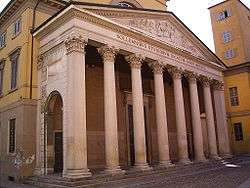
People born in Pavia include:
- Luigi Valentino Brugnatelli (1761-1818), chemist
- Epiphanias, 6th century saint
- Lanfranc (c. 1005–1089), abbot and Archbishop of Canterbury
- Gerolamo Cardano (1501–1576), scientist
- Benedetto Cairoli (1825–1889), twice head of the government
- Carlo M. Cipolla (1922–2000), economic historian
- Francesco Corbetta (1615–1681), guitar virtuoso, teacher and composer
- Tranquillo Cremona (1837–1878), painter
- Claudia Muzio (1889–1936), opera singer
People who have lived in Pavia include:
- St. Alexander Sauli (1591–1592), Bishop of Pavia
- Alessandro Volta (1745–1827), scientist and inventor of the battery
- Simion Bărnuțiu (1808–1864), philosopher and politician
- Giacomo Trecourt (1812-1882), Italian painter
- Camillo Golgi (1843–1926), biologist and Nobel laureate
- Giovanni de Ventura (fl. 1479), plague doctor
- Riccardo Pampuri (1897–1930), saint and medical doctor
- Albert Einstein (1879–1955), physicist and Nobel laureate
- Ugo Foscolo (1778–1827), Italian writer, revolutionary and poet
- Dionysios Solomos (1798-1857), national poet of Greece
- Dante Troisi (1920–1989), writer and judge
Among the illustrious scholars who studied or taught at the University of Pavia, the following are at least worth remembering: Carlo Goldoni, Gerolamo Cardano, Gerolamo Saccheri, Ugo Foscolo, Alessandro Volta the inventor of the battery, Lazzaro Spallanzani, Antonio Scarpa, Carlo Forlanini, the Nobel laureate biologist Camillo Golgi, the Nobel laureate chemist Giulio Natta and Emanuele Severino, one of the most important contemporary Italian philosophers.
See also
- Botanical Garden of Pavia
- Pavese
- Cimitero Monumentale di Pavia (Wikimedia Commons)
Footnotes
- "Superficie di Comuni Province e Regioni italiane al 9 ottobre 2011". Istat. Retrieved 16 March 2019.
- "Popolazione Residente al 1° Gennaio 2018". Istat. Retrieved 16 March 2019.
- "Pavia". Collins English Dictionary. Retrieved 1 August 2019.
- "Pavia". The American Heritage Dictionary of the English Language (5th ed.). Boston: Houghton Mifflin Harcourt. Retrieved 1 August 2019.
- Tuttitalia. "Popolazione Pavia 2001-2018". Tuttitalia. 2019 Gwind srl. Retrieved 10 October 2019.
- "Saint Sebastian Interceding for the Plague Stricken". The Walters Art Museum.
- Thompson, E. A. (1982). Romans and Barbarians The Decline of the Western Empire. Madison, Wisconsin: The University of Wisconsin Press. pp. 61–63.
- Thompson. Romans and Barbarians. pp. 61–63.
- Thompson. Romans and Barbarians. pp. 61–63.
- Thompson. Romans and Barbarians. p. 64.
- Thompson. Romans and Barbarians. p. 64.
- Thompson. Romans and Barbarians. p. 64.
- Moorhead, John (1992). Theoderic in Italy. Oxford: Clarendon Press. p. 19.
- Moorhead. Theoderic. p. 26.
- Moorhead. Theoderic. p. 42.
- Wickham, Chris (1981). Early Medieval Italy Central Power and Local Society 400-100. London: Macmillan Press Ltd. p. 38.
- Moorhead. Theoderic. p. 42.
- Wickham. Early Medieval Italy. p. 38.
- Moorhead. Theoderic. pp. 219–222.
- Moorhead. Theoderic. pp. 223–225.
- Thompson. Romans and Barbarians. p. 95.
- Thompson. Romans and Barbarians. pp. 95–96.
- Thompson. Romans and Barbarians. p. 96.
- Wickham. Early Medieval Italy. pp. ix.
- Christie, Neil (1995). The Lombards The Ancient Longobards. Cambridge, Massachusetts: Basil Blackwell Inc. pp. xxii.
- Christie. The Lombards. pp. xxv.
- Christie. The Lombards. p. 79.
- Paul the Deacon; William Dudley Foulke (2003). Edward Peters (ed.). History of the Lombards. Philadelphia: University of Pennsylvania Press. p. 80.
- Hodgkin, Thomas (1895). Italy and Her Invaders 553 Volume V The Lombard Invasion. Oxford: Clarendon Press. pp. 162–163.
- Arnaldi, Girolamo (2005). Italy and Its Invaders. Cambridge, Massachusetts: Harvard University Press. p. 31.
- Christie. The Lombards. p. 147.
- Christie. The Lombards. p. 188.
- Christie. The Lombards. p. 100.
- Christie. The Lombards. pp. xxv, 101.
- Wickham. Early Medieval Italy. p. 84.
- Christie. The Lombards. p. 200.
- Christie. The Lombards. pp. xxv.
- Dale, Sharon (2001). "A house divided: San Pietro in Ciel d'Oro in Pavia and the politics of Pope John XXII". Journal of Medieval History. 27 (1): 55–77. doi:10.1016/S0304-4181(00)00016-6.
- Scott, Leader (1899). The Cathedral Builders The Story of a Great Masonic Guild. London: S. Low, Marston and Company. p. 50.
- Dale (2001). p. 43.
- Arnaldi. Italy and Its Invaders. pp. 39–40.
- Geary, Patrick J. (2010). Readings in Medieval History Vol. 1. Toronto: University of Toronto Press. pp. 28–45.
- Weinstein, Donald (October 2003). "rev. of St. Augustine's Bones: A Microhistory, by Harold Samuel Stone". The American Historical Review. 108 (4): 1242–1243. doi:10.1086/529942.
- Arnaldi. Italy and Its Invaders. p. 39.
- Arnaldi. Italy and Its Invaders. pp. 39–40.
- Scott. The Cathedral Builders. p. 50.
- Scott. The Cathedral Builders. p. 50.
- Scott. The Cathedral Builders. p. 50.
- Scott. The Cathedral Builders. pp. 50–51.
- Christie. The Lombards. p. 142.
- Christie. The Lombards. p. 142.
- Wickham. Early Medieval Italy. pp. 46–47.
- Wickham. Early Medieval Italy. p. 47.
- Christie. The Lombards. p. 106.
- Wickham. Early Medieval Italy. p. 38.
- Wickham. Early Medieval Italy. p. 47.
- Wickham. Early Medieval Italy. pp. 48–49.
- Quis in igne positus, igne non uratur? Quis Papiae demorans, castus habeatur? Ubi Venus digito juvenes venatur, oculis illaqueat, facie praedatur? Si ponas Hippolytum hodie Papiae, non erit Hippolytus in sequenti die. Veneris in thalamos "ducunt omnes viae." Non est in tot turribus turris Alethiae.
Works cited
- Arnaldi, Girolamo. Italy and Its Invaders. Cambridge, Massachusetts: Harvard University Press, 2005. Print.
- Christie, Neil. The Lombards The Ancient Longobards. Cambridge, Massachusetts: Basil Blackwell Inc., 1995. Print.
- Dale, Sharon. A house divided: San Pietro in Ciel d'Oro in Pavia and the politics of Pope John XXII. Journal of Medieval History 27:1. doi:10.1016/S0304-4181(00)00016-6
- Geary, Patrick J. Readings in Medieval History, vol. 1 Toronto: University of Toronto Press, 2010. Print.
- Moorhead, John. Theoderic in Italy. Oxford: Clarendon Press, 1992. Print.
- Paul the Deacon. History of the Lombards. Translated by William Dudley Foulke, edited by Edward Peters. Philadelphia: University of Pennsylvania Press, 2003. Web. Oct. 15, 2009.
- Scott, Leader. The Cathedral Builders The Story of a Great Masonic Guild. London: S, Low, Marston and Company, 1899. Print.
- Thompson, E. A. Romans and Barbarians The Decline of the Western Empire. Madison, Wisconsin: The University of Wisconsin Press, 1982. Print.
- Weinstein, Donald. Rev. of St. Augustine’s Bones: A Microhistory, by Harold Samuel Stone. The American Historical Review Vol. 108 No. 4, October 2003. Web. October 16, 2013.
- Wickham, Chris. Early Medieval Italy Central Power and Local Society 400 –1000. London: The Macmillan Press Ltd., 1981. Print.
Further reading
Published in the 19th century
- "Pavia", Italy (2nd ed.), Coblenz: Karl Baedeker, 1870, OL 24140254M
- "Pavia", Hand-book for Travellers in Northern Italy (16th ed.), London: John Murray, 1897, OCLC 2231483, OL 6936521M
Published in the 20th century
- Edward Hutton (1912), "Pavia", The Cities of Lombardy, New York: Macmillan Co, OL 7191828M
- "Pavia", Northern Italy (14th ed.), Leipzig: Karl Baedeker, 1913, OL 16015532M
- Egerton R. Williams Jr. (1914), "Pavia (etc.)", Lombard Towns of Italy, London: Smith, Elder & Co., OL 23316028M
External links
| Wikimedia Commons has media related to Pavia. |
| Wikisource has original text related to this article: |
.jpg)